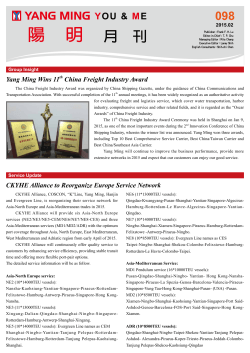
EE 459Lx - USC Ming Hsieh Department of Electrical Engineering
EE 459Lx Ming Hsieh Department of Electrical Engineering EE 459Lx Embedded Systems Design Laboratory (Section 30572: TTH 9:30-10:50) Dr. Allan Weber EEB 410, 213-‐740-‐4147 weber@sipi.usc.edu h?p://ee-‐classes.usc.edu/ee459 EE 459Lx Ming Hsieh Department of Electrical Engineering • EE 459Lx is a Capstone course for seniors in EE/CENG/CESC • Other Capstone courses this semester – EE423 – Loudspeaker design – EE434 – DSP – EE447 – Mixed signal circuits • Students will build a prototype of a commercial product that utilizes a microcontroller plus additional hardware • Class meets for lectures for the first few weeks, after that work on the project • No textbook, quizzes or exams • On the project due date: show us your project Product Development Ming Hsieh Department of Electrical Engineering • The project teams this year will be asked to design some sort of smart device for use in a recreational activity. • It will have a variety of sensors and some number of outputs that can be used to do various things. • It will be up to the teams to decide what it is they want to build. – – – – – Brainstorm some initial concepts Decide on a product to design Present a proposal to the instructor and class Build the works-like prototype to show that it can be done Oral and written presentations to describe the new product Project Teams Ming Hsieh Department of Electrical Engineering • Teams will be picked by the instructor – Probably seven+ teams of students, 3 on each team • Important that students decide by end of week if they will continue in the class. – If you aren’t sure that you want to be in the class, drop now. Don’t drop later when your teammates are depending on you. • Each team will meet with the instructor every week (Monday or Tuesday or ??) to discuss their project • Meetings will be 20-30 minutes, time to be determined • All team members must attend meetings • Bring project notes to meeting and project board if necessary Lab Facility • Projects are built in OHE 240 • Teams have USCard access to lab 24/7 • Project is built on a wire-wrap protoboard • Microcontrollers programmed in C or assembler • Can install development software on your own Mac or PC or use systems in the lab Ming Hsieh Department of Electrical Engineering Parts for Projects Ming Hsieh Department of Electrical Engineering • We stock most common parts for the projects • Teams must decide what other parts are required for their project – Send list to instructor for purchase – Pick up the parts when the arrive – Most items can be obtained in about one week • Use of modules that implement a large number of functions should be discussed with instructor • Project prototype should be finished by week 12 • Teams will use the rest of the semester to design a printed circuit board, have it fabricated, and rebuild the project on the PCB Class Introductions Ming Hsieh Department of Electrical Engineering • On Thursday, everyone introduces themselves and tells us your life story in one minute. – – – – – – – – Where are you from? What’s your major, area of emphasis? What things (engineering or otherwise) are you interested it? What past jobs or internships have you had? What are your plans after graduation? Any job offers? What’s your dream job if you could have it? Are you more into hardware or software? Ever built things using an embedded processor before? • Bring a resume to class on Thursday Embedded Systems Ming Hsieh Department of Electrical Engineering • Embedded system are widely used in all facets of life. • One definition of an embedded system: A special purpose computer that is designed into a larger device to perform a small number of dedicated tasks • Adding a computer to something allows us to do things in software that previously had to be done in hardware • Big advantages in maintaining and upgrading systems – Changing a hardware system ⇒ rewiring – Changing a software system ⇒ reprogramming Embedded Systems Ming Hsieh Department of Electrical Engineering • These days most homes probably have several dozen embedded systems in them:" Thermostat "Cordless phones "Washing machine "Refrigerator "Alarm clocks "Stereo "Microwave oven "Cell phone "TV/DVD/DVR "Garage door opener "and lot of them in your car." "Security system" "Remote controls" "Answering machine" "Sprinkler timer" "Video games" Embedded Systems Ming Hsieh Department of Electrical Engineering • Most embedded system are based on a microcontroller • What’s the difference between a microcontroller (µC) and a microprocessor (µP) used in a laptop/desktop system? – Microprocessor is part of a larger computer system with RAM and general purpose I/O. It’s only the CPU. – Microcontroller is a single-chip with CPU, RAM, ROM and specialized I/O to control electronic and mechanical devices. Embedded Systems • Microcontroller are made by several manufacturers (Freescale, Atmel, Microchip, etc.) • Each produces multiple families at different levels of performance intended for different types of products. • Within a family there may be dozens of models, each optimized for specific tasks – – – – – Automotive Low power Sensing Motor control Lighting Ming Hsieh Department of Electrical Engineering Ming Hsieh Department of Electrical Engineering Embedded Systems • EE 459 teams normally use a general purpose, midrange model like the ATmega328P made by Atmel. • Other µC models can be used if the situation warrants it. • A comparison of microprocessor and microcontroller based systems. Typical desktop system (Core i7) ATmega328P microcontroller Clock Speed 3 GHz < 20MHz Data size 64-bits 8-bits RAM 8 GB 2 KB Storage 1 TB 32 KB $1000 $3.74 Cost Embedded Systems Ming Hsieh Department of Electrical Engineering • Question: Why not use a more powerful microcontroller? • Answer: If you don’t need the capability, why pay for it? – The cost of the µC has to be included in the price of your product. – If you use a more powerful µC, can you add features to the product to justify a higher price? – Figure out what your product needs to do, then use the cheapest processor that will accomplish the tasks.
© Copyright 2025













